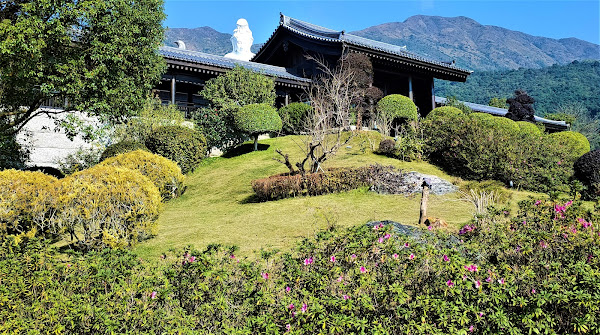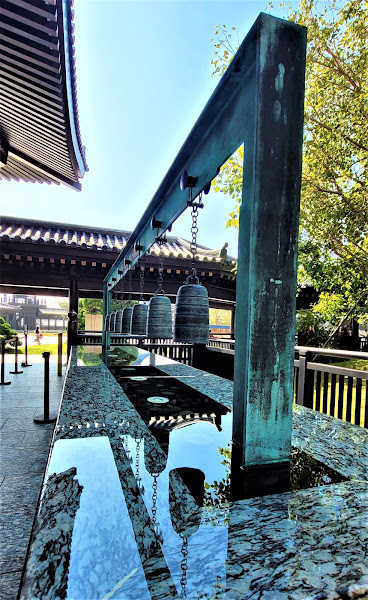In order to preserve my fitness level since my bike accident back in November, when I sustained a hairline fracture in my wrist and was told by the doctor who treated me not to contemplate cycling until March, Paula and I have been going for much longer walks than we would normally do. During one such walk in the week before Chinese New Year, we walked to Ho Sheung Heung (‘village above the water’, the water in question being the Sheung Yue River). On the way back, via a different route, we happened to pass the Kung Chung Temple, a Buddhist temple close to Fanling station, which I’d noticed when travelling to the airport from Fanling and had made a mental note to visit sometime. Of course we went in.
Presumably because of covid-19 restrictions, we were unable to enter the temple itself, but I’ve mentioned this detour because we were given, without asking, two tickets for the Tsz Shan Monastery in the hills east of Taipo for a day last week. Some years ago, I’d cycled up a long and fairly steep hill to the entrance to this monastery, although this wasn’t because I wanted to visit. I was merely checking out all the roads in the area to see where they led to, but I did learn that you have to book online if you want to visit this monastery. So of course we took this opportunity to visit.
The central feature of the monastery is a huge statue of the goddess Guanyin, which you cannot fail to notice when cycling along Tin Kok Road to Plover Cove, which I used to do regularly before the start of the pandemic.
This was our first view of that statue when we entered the grounds of the monastery:
If we were to visit again, we would go up these steps:
…but we continued to the right because the statue seemed to be the main attraction, although I did notice that the guardians on each side of this temple didn’t appear to be the conventional lions or lungma that I might have expected (see below).
The statue grew ever larger as we drew nearer:
The next three photos give you a good idea of how tall and imposing it is:
And this is the closest view among the photos I took of the statue:
According to Wikipedia, it is 76 metres high, although I do think that this is an exaggeration (my own estimate was 40–45 metres). However, to Wikipedia’s credit, the entry on its pages has been flagged as ‘…contains content that is written like an advertisement’. I believe that my estimate is closer to the actual height!
The plinth upon which the statue stands is described in this article as a ‘lotus platform’, which you can see clearly in the previous photo. I took the next photo to show the elaborate patterns in the wall beneath the lotus platform:
The structure underneath the statue is a museum, and my main memory of it is that it was so dark inside—only the exhibits were illuminated, not brightly—that it took me 15–20 minutes to be able to see the floor. Most of the exhibits were of figures from the Tang (AD 618–907) and Ming (1388–1644) Dynasties, although whether they were genuine antiques or merely reproductions I’m unable to say. You can see the entrance to the museum in this photo taken by Paula:
And this is the first photo I took after leaving the museum. The monastery’s main temple is on the right:
There were notices prohibiting photography inside this temple, but I took this photo, which shows the three deities enshrined here, from a short distance outside:
You can tell that it was taken around the new year because of the kumquat bushes, which are a symbol of prosperity in Chinese culture.
We also took a few photos along the side of the main temple, which you might describe as quasi-abstract:
Paula took the second and third photos.
The next four photos are general views of the area between the statue and a smaller temple facing the statue:
You might describe this as the ‘correct’ approach to the statue from that temple:
Paula also took this photo, which shows what I would describe as the equivalent of a cloister in a mediæval European monastery, leading away at right angles from the smaller temple:
…while I took this photo of the shrine inside the temple (before I noticed the small ‘no cameras’ icon on the right, which stopped me taking photos of the two figures, each about 6–7 metres high, on both sides of the shrine):
As I was coming down the stairs towards the main entrance, it struck me that it would make a good photo looking out to sea—if only there weren’t people in the frame:
But there were people, standing idly, in the frame (of the doorway):
However, I did eventually manage to get a clear shot:
Finally, here are photos of the two guards that I mentioned at the start of this report. Both have names and are traditional guardians of the Buddha. This is Naluoyan Jingang (on the left):
…and Miji Jingang (on the right):
And that was our visit to the Tsz Shan Monastery. Like the Ten Thousand Buddhas Monastery in Shatin, construction began in the 1950s, so it is not an historical site, although it is certainly interesting. According to the brochure that we were handed at the gate, the architecture here is a traditional style that was popular between the Tang and Northern Song (AD 960–1127) Dynasties, which probably explains why I didn’t see a single dragon motif anywhere, unlike, for example, Wun Chuen Sin Koon, a Taoist monastery on Ping Che Road, northeast of Fanling, which has hundreds of golden dragons adorning both the external and internal walls of its main temple. Although we enjoyed our visit, we’re unlikely to come here again, mainly because access isn’t easy. The minibus that we took from Taipo Market station merely passes the bottom of the hill that I referred to above.
Monday, 30 January 2023
Subscribe to:
Post Comments (Atom)































“Construction started in the 1950’s” interesting ,who would have financed it? A dangerous time to have any religion other than communism I’d have thought.
ReplyDeleteI realise I’m exposing my towering ignorance about China and it’s history. The more I learn the less I know.
John
Don’t forget that Hong Kong was a British colony at the time. A lot of the work here was financed by local taipan (businessman) Li Ka-Shing.
DeleteIt is an interesting place to visit becaise we could enjoy the ambience without being in crowds...
ReplyDeleteI think that having to book a visit online is the reason for the absence of crowds. I assume that they restrict numbers.
Delete